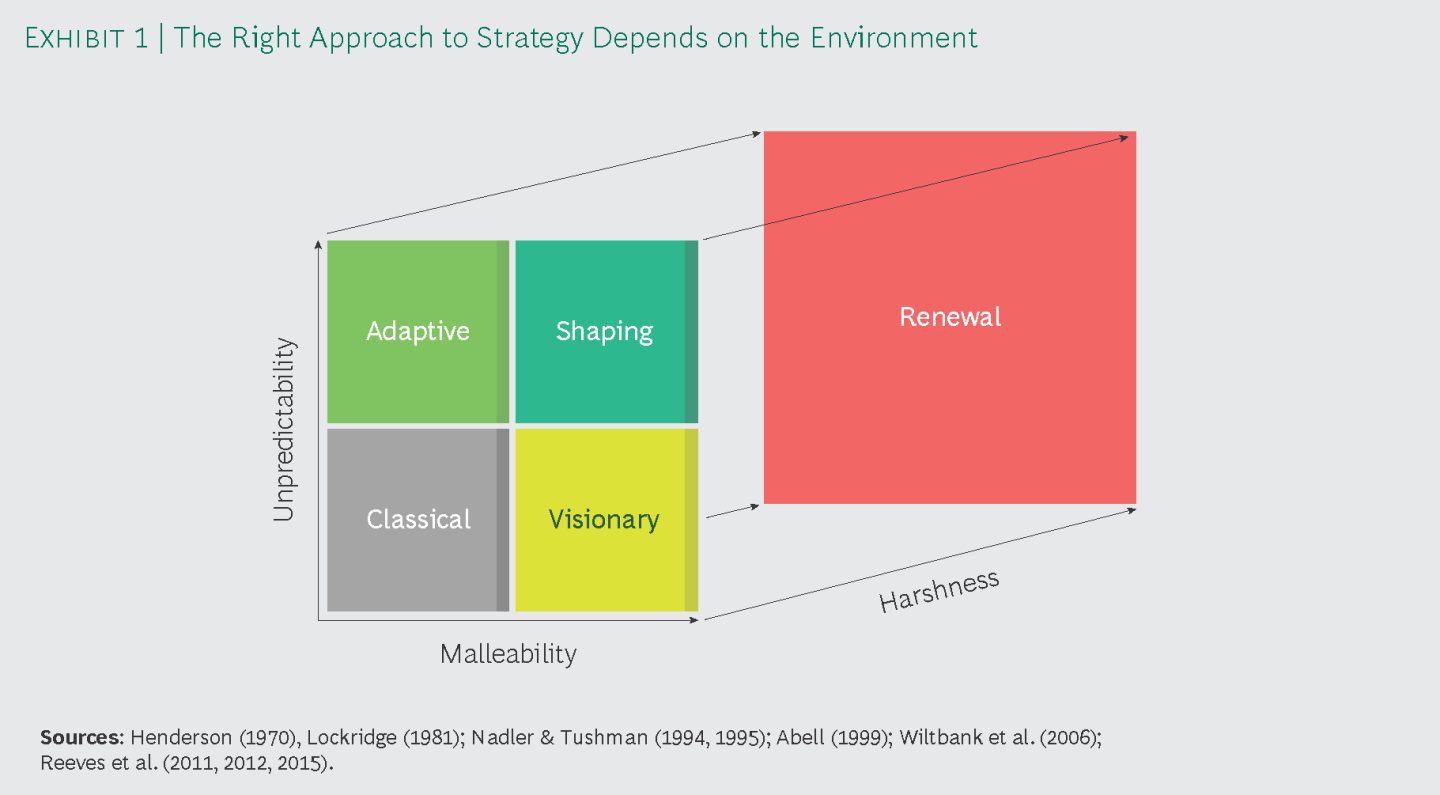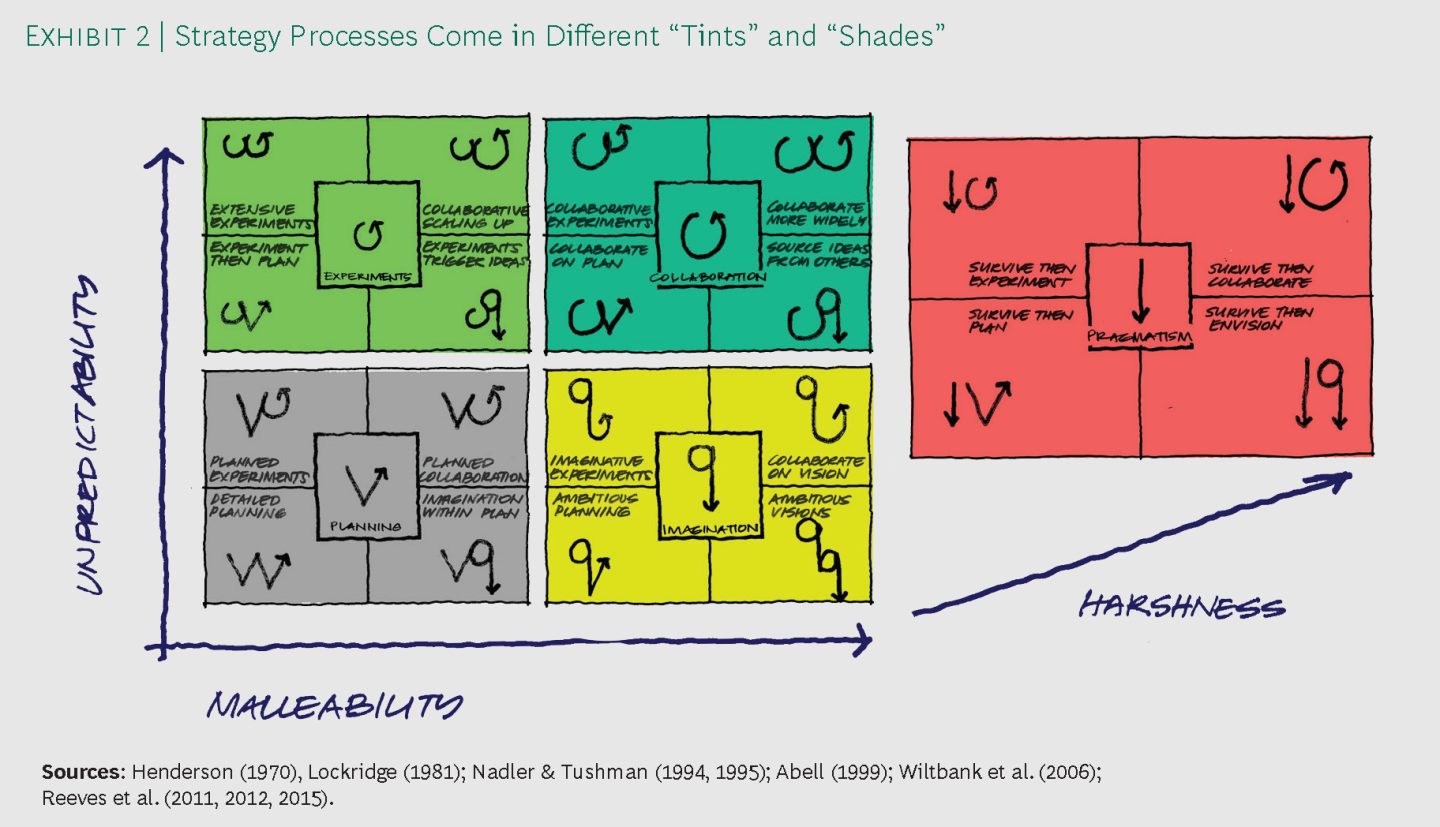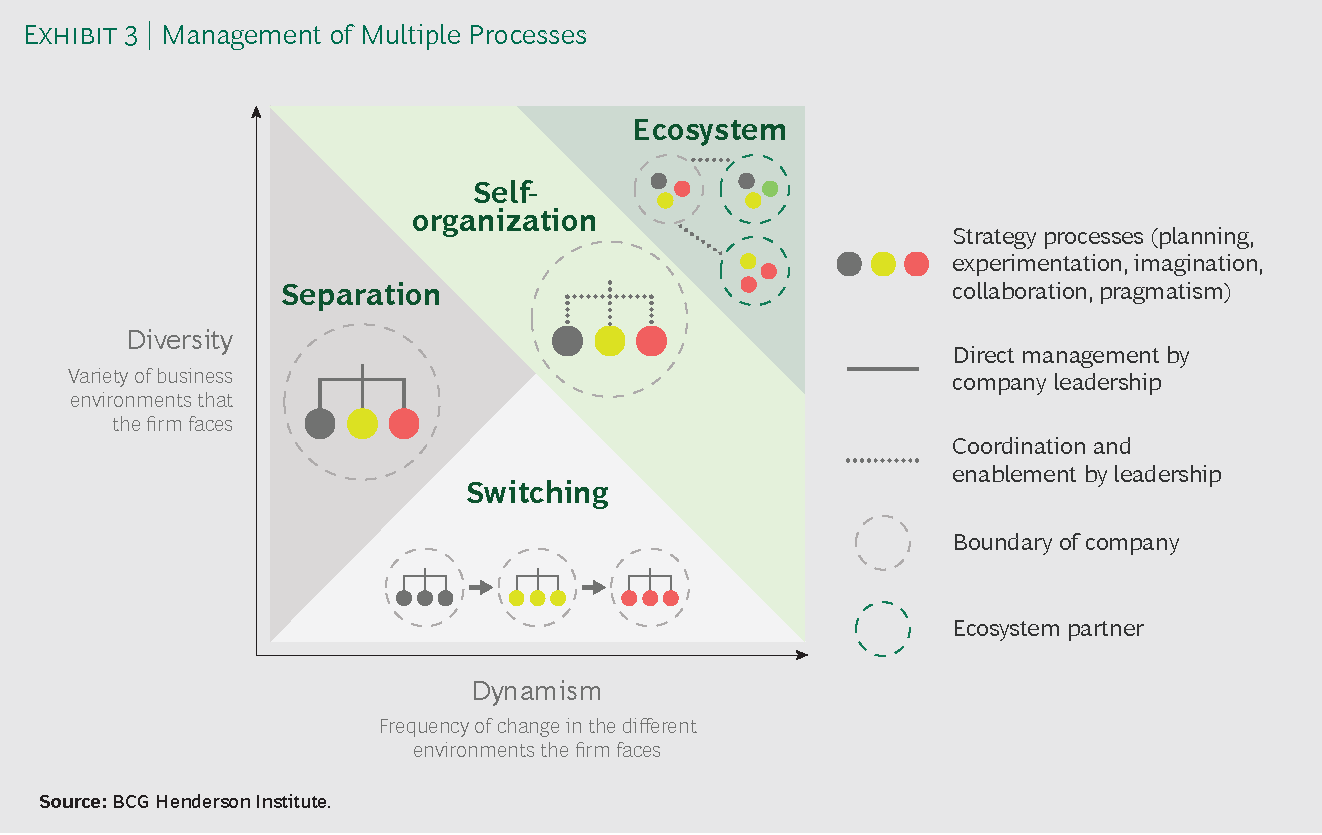Since the birth of business strategy as a discipline in the early 1960s, business leaders have had access to an ever wider range of approaches to strategy: the classical plan-and-execute approach, adaptive strategy, ecosystem-based strategy, blue ocean strategy, value migration, the dynamic capabilities approach, and so on.
But despite this broadening array of approaches, the process of developing and realizing strategy within a company has remained essentially the same: strategic planning. Senior executives supply an ambition and direction, business units develop a more detailed plan grounded in market and competitive analysis, and the plan is challenged, finalized, and adopted until the next planning cycle. The problem is, there can be a dramatic mismatch between this process and the business environment. Fast-changing conditions can quickly make any plan obsolete. A company may need to be more experimental and exploratory, or to co-evolve with other actors in a multicompany ecosystem, for instance, neither of which is facilitated by episodic, company-wide planning cycles.
We need to rethink the process by which we define and operationalize strategy. We need to widen the process options available to the strategy function, so that our strategy truly helps us win in the specific business environment we are facing.
The Challenges of Different Environments
As business environments have grown more diverse in recent decades, picking the right approach to strategy for each context has become increasingly important. We can define five broad approaches to strategy (see graphic below):

1. Classical: clear phases of analysis, planning, and execution; useful in predictable and stable contexts, such as mature categories that grow with GDP (confectionary and cosmetics, for example)
2. Adaptive: continual experimentation and scaling up of what works; useful in unpredictable environments in which new technologies or business models drive changing offerings and patterns of demand
3. Visionary: use of imagination to create a game-changing product, service, or business model, followed by persistence in the creation and development of a market; useful when a firm can have a significant influence over the environment rather than merely adapting to it
4. Shaping: collaboration in environments that are simultaneously unpredictable and malleable, requiring companies to leverage ecosystems and platforms
5. Renewal: execution of necessary, radical moves when the environment is harsh or there has been a protracted mismatch between the firm’s strategy and its environment, with limited time and resources to analyze and deliberate a course of action
A leader needs to get three things right around strategy: read the business environment correctly; choose a general approach to strategy that fits the environment (i.e. the list above); then set up a process that enacts this approach in their particular company.
Even if an executive gets the first parts right and identifies the right approach — for example, ‘renewal’ — the company may end up sticking with the classical, firm-wide cycles of planning, or setting up multiple experiments, processes which would be too slow or not radical enough for a renewal strategy. And so the initial, insightful intention — the chosen approach — is not realized in practice.
Linking up the approach and the process is not easy. When General Electric set out to become a leading digital company around 2011, for example, then-CEO Jeff Immelt was aware of the need for an adaptive approach. As he noted, “One of the hardest challenges in driving change is allowing new information to come in constantly and giving yourself the chance to adapt.” This approach, however, was in some ways at odds with the way GE actually developed and operationalized its particular strategy. Backed by large investments, it set out a major vision: to create the “operating system for the industrial internet.” As Immelt reported, “We have hired thousands of people and invested billions in technology.” According to interviews with GE managers, these moves ran up against the fast-changing IoT environment, which, as Immelt suggested, did require adaptability, even from a company with GE’s resources. GE has now shifted course, focusing on experimenting with industrial apps for existing customers — a process more coherent with an adaptive, “test and scale” approach.
GE’s example demonstrates the importance of coherency not only between the market reality and the broad approach to strategy, but also between these and the process for developing and realizing the company’s particular strategy.
Five Kinds of Strategy Process
Let’s consider the processes best suited to different approaches to strategy. For each of the five approaches outlined above, we can define a matching process.
Classical: Planning
The essence of the classical approach is to create and implement a stable plan of action, which works best when the environment is relatively predictable. The job of the process, then, is to enable the creation of an actionable plan.
The initial direction or ambition comes from the executive team; this is usually followed by various kinds of analysis, like market modeling (projecting category growth and future share) and detailed financial forecasting. This process takes some time because ideas have to be analytically verified and consolidated, with the final call made by the executive team. An example is the strategy process in the core business of Mars. As past president Paul Michaels noted, “We plan because we operate in relatively stable markets.” After consultation, plans are set from the top by a small group: “It’s me, the CFO, and a few others.”
We can represent this planning process with the letter v. That is, starting from the top left of the v, the executive team sends the initial direction down to the business units (the bottom of the v), which send elaborated plans back to corporate, which finalizes the plan.
Adaptive: Experimentation
In less predictable environments, centralized cycles of planning make less sense. Instead, the strategic approach is to experiment and adapt rapidly in order to match and exploit unpredictably changing conditions. The process here, then, is about facilitating and capitalizing on experimentation.
This works best when experimentation happens in short cycles of testing and picking winners. Key ingredients of the process are the ability to collect and read signals to detect business opportunities; free flow of data throughout the company, enabling teams to identify opportunities with little central supervision; and the culture and organizational mechanisms to enable failures to be easily discontinued successes to be scaled.
Zara enacts its adaptive strategy in this way, identifying emerging trends via real-time market experiments with its clothing styles, making small commitments — only 15% to 25% of a season’s line is set six months in advance — that can quickly be scaled up. This process can be captured by the letter o, to represent short, iterative cycles of testing and identifying opportunities.
Visionary: Imagination
A visionary approach works when the market is malleable to a particular company, so that rather than simply responding to given conditions, the company can create or shape a market around a transformative offering. In this case, the job of the process is to facilitate imagination, to hone in on a visionary product, service or business model, and then persist resourcefully to drive this into the market.
Imagination works in iterative cycles, taking a starting point — often a desire, or a frustration that a need is not being met–and elaborating it into a worked-out proposal or prototype. In popular stories of imagination, like that of Steve Jobs, this process is assumed to occur in the head of one person. But in fact it is a social process: at Apple, Steve Jobs elaborated his ideas by iterating with Jony Ive and others. To take another example, the concept behind 23andMe was formulated over time by Anne Wojcicki, drawing on her experience in health care, refined in discussions with scientists and engineers.
Key ingredients of this process are the richness of mental models brought to bear on the initial ideas; a willingness to be patient with ideas still in formation; effective learning from prototypes; and a determination to persist until a market has been created. It can be represented by the letter q, with the circular portion standing for imaginative iteration within the company. Then once the visionary product has been created, it must be driven to market: the tail of the q.
Shaping: Collaboration
When an environment is malleable yet unpredictable–meaning it would be unwise to commit to a long-term visionary effort–an ecosystem or platform-based approach is appropriate. The strategy process here is about supporting effective collaboration to shape an unpredictable environment to the advantage of the company and others whose interests coincide.
Alibaba has done this exceptionally well, building a popular platform, engaging others, and shaping the direction of e-commerce in China. Another example is Red Hat, which creates open-source software by engaging a community of programmers. Success with this process requires building a platform to coordinate collaboration and co-evolving the offering in concert with other actors. It also requires building a highly responsive organization; Alibaba leads here, aiming to become a self-turning organization, with “as many operating decisions as possible made by machines fueled by live data” drawn from its ecosystem.
We can represent this process with a capital O. Like the adaptive, experimental process (represented by the lower-case o), the collaborative process involves cycles of testing, learning, and evolving the firm’s ideas and tactics. However the larger size of the oval signifies that the process encompasses actors beyond the bounds of the company.
Renewal: Pragmatism
When the environment becomes so harsh that the company’s viability is threatened, immediate corrective actions are required. The job of the strategy process here is to facilitate fast interventions; it involves making pragmatic choices under pressure to find a path back to growth.
We can represent this process by I, indicating top-down, fast decision making that aims to ensure survival. Doing this well is difficult, as time and therefore the quality of information may be limited. There is little scope for comprehensive analysis or engagement, internally or externally. Rather, a few critical turnaround initiatives must be driven from the top. An example is American Express in the harsh environment from 2008 to 2009. “First we had to deal with the cost issue…we had to act immediately,” explained then-CEO Ken Chenault, emphasizing the need to analyze the firm’s cost structure as a basis for quick cost-saving decisions, followed by “selectively investing in growth.”
Customizing Strategy Processes
The five strategy processes described above are really points on a continuum. So we should also consider how they can be combined into variations appropriate to different circumstances.
Two commonly employed variants illustrate this idea: v (the planning process) is often extended to become a w, indicating further rounds of iteration between corporate leadership and the business units. Similarly, v (the planning process) and o (the adaptive process) are often combined to form vo, meaning: an initial exercise to define some guiding principles, followed by continual reassessment as the company learns what works and what doesn’t.
Many other variations are possible. For example: multiple programs of experimentation run in a persistently unpredictable environment (oo); initial ecosystem engagement setting the direction for subsequent adaptive experimentation (Oo); an initial phase of experimentation informing an imaginative, visionary effort (oq).The graphic below shows the different tints and shades available in the palette of strategy processes (see graphic below).

Managing Multiple Strategy Processes
The majority of companies employ a single strategy process–usually classical planning–rolled out uniformly. But a large company almost always faces multiple business environments, across time or simultaneously in different parts of the company. Environments that are more or less predictable and malleable require different strategic approaches, each enacted via a suitable process. Thus, business leaders and strategy departments need to be able to manage multiple variants of strategy processes.
Like someone working with both hands at once, an “ambidextrous” business can deploy different strategic approaches across business units–one unit taking a classical approach and another taking an adaptive approach, for example. Such businesses need ambidexterity in processes, too, meaning that the different strategic approaches need to be successfully operationalized.
Leaders of such ambidextrous business need to define “metaprocesses,” that is, a way of orchestrating different strategy processes across a complex firm. How this should be done depends on diversity (the variety of business environments the company faces) and dynamism (the frequency of change in those environments). Along these dimensions we can define four such metaprocesses (see graphic below).

1. High Diversity, Low Dynamism: Separation
When the diversity of environments is high (the business faces many kinds of environment at once) but dynamism is low (this set of environments stays the same), it makes sense to run separate strategy processes in parallel, overseen by corporate leadership.
This requires leaders to be familiar with a range of approaches to strategy and the processes needed to enact them. They should be aware of the different demands of each process and its expected outputs: annual plans from a classical unit, plausibly transformative ideas from a visionary unit, and so on. Former CEO of PepsiCo, Indra Nooyi, has described this kind of separation: “The team that runs the core business should keep doing what they’re doing efficiently… the other teams should not be motivated by the current model but focus totally on disrupting it.”
2. Low Diversity, High Dynamism: Switching
When diversity is low but dynamism is high (the firm faces just one kind of environment, say, but this changes over time), it makes sense to switch processes along with major shifts in the business context. This requires business leaders to regularly reassess the environment and be ready to change the strategy process as needed–even if this involves disruptive top-down interventions in existing ways of working. ING Bank Netherlands did this successfully, switching from a classical to an adaptive, “agile” approach as the relatively stable banking environment was disrupted and became less predictable.
3. High Diversity, High Dynamism: Self-Organization
In diverse and dynamic situations, top-down management becomes too complex to be tenable. The executive team should instead leave room for business units to self-organize, determining the most suitable strategy process given the environment that each faces at any given time. Corporate still has a role to play, though, in creating the “internal market” for resources and the rules that regulate its operation.
Consumer electronics company Haier developed such a model, aiming to build an “enterprise… able to operate by itself with employees acting as their own leaders.” It organized the company into 2,000 largely self-governing units, while the CEO aimed to become “a leader whose existence is unknown to his subordinates.”
4. Very High Diversity and Dynamism: Indirect Influence
In the most diverse and dynamic situations, a firm may not be able to pursue the full suite of required processes internally and instead need to orchestrate an ecosystem, or multiple ecosystems, of external partners. In this case, leaders must do what they can to shape the ecosystem favorably, while collaborating with partners who may be running very different strategy processes. This is often achieved indirectly via a digital platform, such as a two-sided marketplace. For example, Apple has a visionary process for many of its products, while within its app store, many companies run experimental, adaptive processes; at the same time, Apple collaborates with manufacturers that face comparatively predictable environments and employ classical strategy processes. There is no way that Apple alone could exploit the full range of environments across its ecosystem; it would be impossible to manage the entire app store and all of Apple’s other partners as departments of one company. But Apple profits by collaborating with multiple companies running different strategy processes.
Reinventing the Strategy Function
Adopting multiple approaches and processes simultaneously requires a reconception of the role of the strategy department. As the guardian of strategy, the strategy function should aim to move the organization away from a monolithic approach, towards being able to implement a variety of strategy processes. The actions required to achieve this are:
- Educate the company. Ensure that everyone understands both the need for multiple approaches to strategy and the processes required to operationalize them.
- Set the tone with the right questions. The different processes are also defined by different questions: each signals a different way of thinking and acting appropriate to the chosen strategic approach.
- Build the needed capabilities. Hire, deploy, and cultivate talent able to work with different approaches to strategy, and provide the tools (frameworks, exercises, games) required to develop those strategies.
- Determine the right mix of strategy approaches. Company strategists should monitor the environments in which the company operates and identify the approaches and processes best suited to each situation.
- Choose the right metaprocess. Determining the way to manage multiple strategy processes at once is a critical task for the strategy team and senior executives.
- Be a change agent. Ensure that the company does not stick with processes maladapted to the environment(s) it faces.
- Govern strategy effectively. Develop a process library, that is, guidelines for business units or the firm as a whole in choosing the right strategic approach and the process for carrying it out.
Two companies that have achieved these goals are Mahindra and Alibaba.
Mahindra refers to itself as a federation of businesses, educating its leaders to be orchestrators “sensitive to the different pieces and how they flow together.” The Strategy Group operates several types of strategy “war rooms” that study trends and challenges, budget questions, and operations, employing an 11-question framework designed to challenge and strengthen business unit strategies. It orchestrates process variation across the company according to each business unit’s stage of development in its market. For units facing classical environments, the central team “drills down into incredible detail” on the unit’s plans, while emphasizing the need for feedback loops in younger, more experimental businesses.
As described by its CSO, Ming Zeng, in his recent book, Alibaba aims to be a “self-tuning enterprise.” “Embrace change” is a core tenet of Jack Ma’s leadership; the company educates its leaders by means of frequent rotations among business units.² Units have a high degree of autonomy and the ability to run their own experiments. The central Alibaba planning process leaves space for this: ‘plans’ are written as starting points rather than ends in themselves, and business unit leaders are allowed to explore new directions. Finally, when change is needed but difficult, Alibaba still has the ability to initiate tightly executed programs from the top, best illustrated by the significant number of reorganizations the company has gone through over the course of its growth.
Even for those leaders who understand that varied approaches to strategy are required, it can be difficult to realize these organizationally. Companies are often stuck with a classical plan-and-execute process, which is as much an embedded mindset as a set of collective routines. To best take advantage of each environment a firm faces, we need to actively consider the right strategic approaches and enact these effectively by adopting the right processes.



